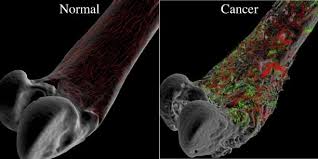
A bone tumor, (also spelled bone tumour), is a neoplastic growth of tissue in bone. Abnormal growths found in the bone.
Bone cancer can be distinguished into primary bone cancer or secondary bone cancer. Primarybone cancer starts in the bone.
Bone cancer
It’s a malignant (cancerous) tumor of the bone that destroys normal bone tissue. Not all bone tumors are malignant. In fact, noncancerous (benign) bone tumors are very common than cancerous ones. Both malignant and benign bone tumors will grows and compresses the healthy bone tissue, but the noncancerous tumors will not spread, do not destroy bone tissue, and are rarely a threat to life.
Malignant tumors begins in the bone tissue are called primary bone cancer. Cancer that spreads (metastasizes) to the bones from other organs of the body, such as the lung, breast, or prostate, is called metastatic cancer, and it is named for the tissue or organ in which it began. Primary bone cancer is far less common than cancer that spreads to the bones.
Types of bone cancer:
Causes of bone cancer:
Symptoms of bone cancer:
Diagnosis:
Treatment:
Treatment options depend upon the size, type, location, and stage of the cancer, as well as the person’s general health and age. In general the treatments are available for the bone cancer includes surgery, chemotherapy, radiation therapy, and cryosurgery.
Surgery: It’s the common treatment for the bone cancer. During the surgery, doctor will remove the entire tumor with negative margins (no cancer cells are found at the border of the tissue or edge of the tissue removed during surgery). The surgeon may also use special surgical techniques to prevent the amount of healthy tissue removed with the tumor.
Chemotherapy is the drugs used to kill cancer cells i.e. anticancer drugs. Bone cancer patients usually receive a combination of anticancer drugs.
Radiotherapy also called Radiation therapy, which involves the use of high-energy x-rays to kill cancer cells. This treatment may be used in combination with surgery. It is often used to treat chondrosarcoma, which cannot be treated with chemotherapy, as well as ESFTs. It may also be used for patients who refuse surgery.
Cryosurgery is the use of liquid nitrogen to freeze and kill cancer cells. This technique can sometimes be used instead of conventional surgery to destroy the tumor.
Cancer, benign, malignant, tumor, pain
references: